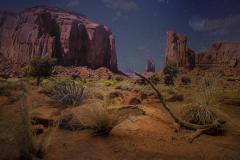
Under the Sun
Itamar Freed
Preview exhibition works here
View video of Itamar's spectactular installation artwork here
Through photography and mixed media, Itamar Freed crafts hyper realistic representations of portraits and landscapes. His ongoing body of work features habitats from across the globe, questioning the distinctions between the natural and artificial, real and manufactured. The encounter between the three territories – the wild, the cultured and the staged – creates intriguing scenarios and instigates questions around aesthetics, politics, culture, boundaries, and reality.
Generations come and generations go,
but the earth remains forever.
The sun rises and the sun sets,
and hurries back to where it rises.
The wind blows to the south
and turns to the north;
round and round it goes,
ever returning on its course.
All streams flow into the sea,
yet the sea is never full.
To the place the streams come from,
there they return again.
All things are wearisome,
more than one can say.
The eye never has enough of seeing,
nor the ear its fill of hearing.
What has been will be again,
what has been done will be done again;
there is nothing new under the sun.
Is there anything of which one can say,
“Look! This is something new”?
It was here already, long ago;
it was here before our time.
No one remembers the former generations,
and even those yet to come
will not be remembered
by those who follow them.
Ecclesiastes 1: 4 - 11 (NIV)
Through this lens, Freed continues his ongoing photographic research into landscape and portraiture. Under the Sun raises questions about the linear and cyclical passage of life and Freed’s ongoing search for meaning. Freed asks questions about the ability of the photographic medium to preserve, to freeze and to grasp life and nature to create a threshold between real and imagined, beyond the bounds of time and place. For him, the photograph is a token, a sentimental relic of a moment in time.
Portraits
In this show, Freed researches the borders between the photographic medium and sculpture. Under the Sun features a series of Polymeric photographic facial casts of Australian parents and their children – these function as sculptural images, as death masks, upon which Freed projects and digitally maps their own portrait photographs. The projected image resembles a photographic skin made out of light. In this act of mapping projection and by combining light and material, the artist momentarily revives these people, fixes them in their own time, forever, as if taken from a frozen memory or time capsule. Freed wants the viewer to see the individual he sees before him at the exact moment of casting, to preserve the life he sees before him - the act of looking is used to serve two functions: to identify others and therefore, reflect upon ourselves. Identification asks “who are you?” and in turn divides the self from other, the photographer and his subject. In this work Freed is revealing the genetic connection between generations, the identity, information and history preserved in genes although forgotten in the mind.
“There is first the uprightness of the face, it’s an upright exposure, without defense. The skin of the face is that which stays most naked, most destitute. It is the most naked... It is the most destitute also: there is an essential poverty in the face; the proof of this is that one tries to mask this poverty by putting on poses, by taking on a countenance”.
Emmanuel Levinas, Ethics and Infinity, trans. Richard A. Cohen (Pittsburgh, PA: Duquesne University Press, 1985), p.86.
Still Life
Freed is examining the root of image making, at its most fundamental, questioning our vision. “The eye never has enough of seeing”, we have a never-ending hunger for visual stimulation. Our world is saturated with images, digital and physical. We cannot escape this oversaturation. It appears that the more we are confronted with, the less we actually see. This abundance overwhelms our gaze and we become increasingly bored and distracted. This is the contemporary gaze – this inability to fixate, to concentrate and to look. Freed is interested in the contradiction between seeing and looking. Flowers Series, a study of Vincent Van Gogh’s Sunflowers, examines the photography at its most primary, stripped down into red, yellow and blue, positive and negative and algorithm generated colours. The work offers a surreal hyperrealism, in which he refines each singular element, before beginning the reconstruction of the image.
Landscape
“As a photographer, Freed is interested in the representation of landscape and in how images of places may come to displace or augment our understanding and memory of them. He is concerned with disappearing habitats, but also with vanishing notions of realness —whether that comes in the form of a simulated environment or via a digital photograph of unknown veracity. Some of the natural scenes in his oeuvre are in fact of places he has never visited, but which he conjures all the same. In his practice, Freed explores how we come to understand what is “real” through replicas and how we imagine the places we’ve never been.”
Magda Nakassis, Editor and Writer
Freed creates photographic and sculptural representations of place, time and identity that are a synthesis of natural landscape and people. For Freed, images form an axis between painting and reality – comprising imagined narratives controlled by himself, and the actual objects documented by the camera. The works alert the viewer to the impact of technology on our perception of our identity and to the dissolving of two seemingly separate categories – nature and culture.
